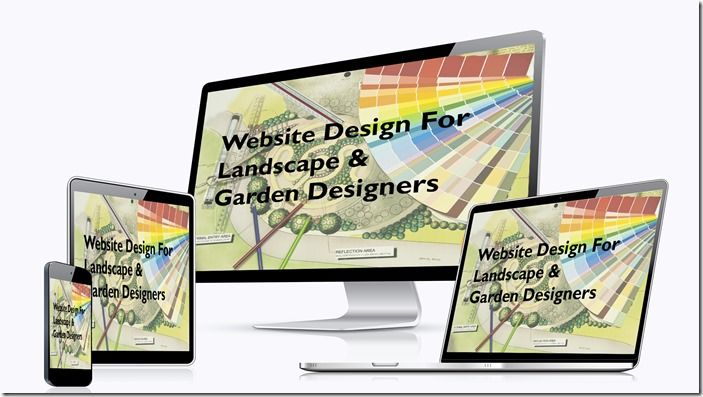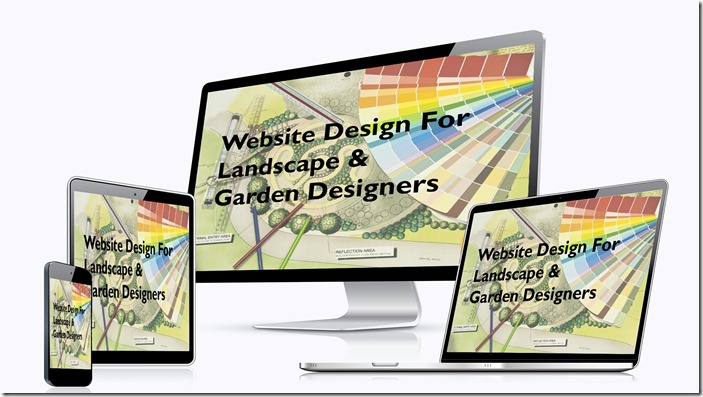For further information on website design for landscape and garden designers click here to download our student notes

A Digital Portfolio: Website Design for Garden Designers

Your website is your shop window. A digital portfolio which can be easily changed and updated. In this 2 part article we’ll discuss what to include, what not to include, where to host yours, and tips for designing and maintaining one. We’ll cover everything you need to know to make one that’s flexible and useful over time whether you’re a student or a professional.
Your Website As A Digital Portfolio
A website is a professional statement of who you are, the kind of work you do, and your design philosophy. It speaks for your brand in your absence and everyone needs one. First off, there are a number of decisions you’ll need to make. Firstly, to either hire a web designer or use one of the many self-creating template websites now available. No matter which you choose, the currency of a website and your digital portfolio is imagery, usually in the form of JPEGs. You’ll also need some text, a bio and a backbone of metadata.
Digital vs Paper Based Portfolios
The advantages that a digital portfolio has, over traditional paper based options, is that they allow your work to be easily shared, collaged and manipulated. They can quickly be updated with new work as you complete it and they also allow you to use audio and video to present your work. Furthermore, a website’s distinct advantage is related to online search and metadata. But we will get to that later.
Choosing A Platform
While employing a website designer is one option, I would recommend using a free website builder and building your own. It’s simple and straight forward with the biggest advantage of being able to update it whenever you want. If you don’t have a website or your existing one needs updating.
I recommend using Wix.com because it’s easy to use. It’s mobile compliant (Very important as >50% of all traffic now comes from mobile phones). The templates are minimally styled with simple navigation and full-screen galleries. This allows your work to be the most prominent content on the page.
The best website not only showcases your work, they narrate who you are as a designer, how you see the world, and something about your personal design process. Use it to narrate your story. At a minimum, I think your site should include two pages an About page and a Portfolio, as you have time you can build it out from there.
“As a minimum, your site should include just 2 pages – an About page and a Portfolio”
Digital Portfolio Page
Your digital portfolio page should only include your best work. You only have a short time to convince someone you’re worth a second look, 60-90 seconds at most. A few remarkable projects are preferable to many half-baked ones. Supplement with minimal, descriptive text in the sidebar. The infographic style which overlays paragraphs of text on the image won’t be read by anyone online and it only serves to confuse the viewer.
Inspiration
You should look to other professionals such as architects, to see how their portfolios are structured. Take note to only use properly exposed, well-composed photographs Use simple line work for floor plans, elevations and sections when they exist and present models and renderings without any overlaid text. This forces you to focus on the work, not a sidebar or lots of text or fancy iconography.
Who’s it for?
At this point in the creation of your digital portfolio, you need to think of yourself as doing market research. Simply list the questions your readers could ask, in their own words. Your readers will come from different places for different reasons. Some readers will come through a request in Google.
Often this is the most common way for your site to be found. Readers are using the web to answer specific questions they might have. Sometimes they are looking to plan a holiday or other times to purchase an item.
Others will find your site by clicking on a link they find on another site. This could be a Facebook link shared by a contact or on a flyer or a business card. Still, other readers are returning to your web site. It may be for more information or maybe they want to keep on learning about your activity or to make a purchase. Perhaps you keep a blog on your site and they want to check the latest entry.
Architects & Property Developers
If you are looking to generate work from fellow professionals such as architects, they will be most interested in seeing your design philosophy. i.e. your hand sketches, your models alongside your finished rendered computer models. The ability to graphically communicate your ideas using hand drawn sketches could set you apart from the composition, so don’t be afraid to include them in your portfolio.
Content
It may seem obvious, but often it is not so easy to put aside your own preconceived ideas in order to let the reader’s needs shape your site… Precisely what you choose to show should be influenced by the type of work you’re after. Now, this applies to students, interns, and professionals alike. If you fill yours with slick computer renderings and no sketches it tells me that your competency is computer rendering. This may be fine for some clients, but others may want to see hand drawn sketches.
Computer Rendering
I think computer rendering is great when done well. But I also think they can put people off. whereas the best hand renders illustrate your artistic viewpoint: a garden’s true nature, the messiness of the world, a narrative, a story. Showing some versatility is a plus too, even for seasoned pros. Sculpture, photography, drawing, furniture design, painting; whatever creative pursuits you engage in when you leave the studio should have some sort of home in your portfolio.
Student Websites
Including academic or theoretical projects is usually your only option early in your career. As you begin practicing and building things, always be photographing and documenting your work with your portfolio in mind. Process imagery, (your hand-drawn sketches) will often get lost, but an architect will often find this more compelling than the final work. It’s proof of your skill as a designer and your ability to steer your ideas through the minefield of design and construction.
Construction Drawings
I’m assuming if you’re building gardens in the real world, you’ve got this figured out and if not, you need to do our CBPP course. If you’re an intern or graduate from a reputable course, then you too should have an example which will set you apart from the competition. The ability to produce full construction and specification documents sets you apart from the other 50% of designers who can’t. Show these in your portfolio and explain why they are so important.
Transitioning From Student To Professional
There comes a point in your career when you’re transitioning from student academic work to built-work. Always tailor your digital portfolio to the narrative you’re advancing. If all you have are planting images or pictures of design details, use these to tell your story. An established designer is likely to have all built gardens and no academic work in their portfolio.
Old Work
Your digital portfolio shouldn’t contain every bit of work you’ve ever completed. Populate it with your best and most current work. Gardens from five years ago might look dated.
Professional Photography
The jump to professional photography is a big step. But, think about the time investment of designing and building the work. Isn’t that worthy of hiring another pro to document it properly? It has little value if the photographs don’t compliment the quality of your design. And, image quality directly correlates to what you can charge for your services. Again, it’s all about the narrative.
DIY Photography
If you can’t afford professional images invest in a good DSLR and learn to use it along with Lightroom and Photoshop. When including project images from a previous employer be sure to get permission. If necessary, purchase the rights to use the images on your site beforehand. If you don’t have good photography for a project, leave it out. Poor photography calls into question your other work as well and your judgment for including it


